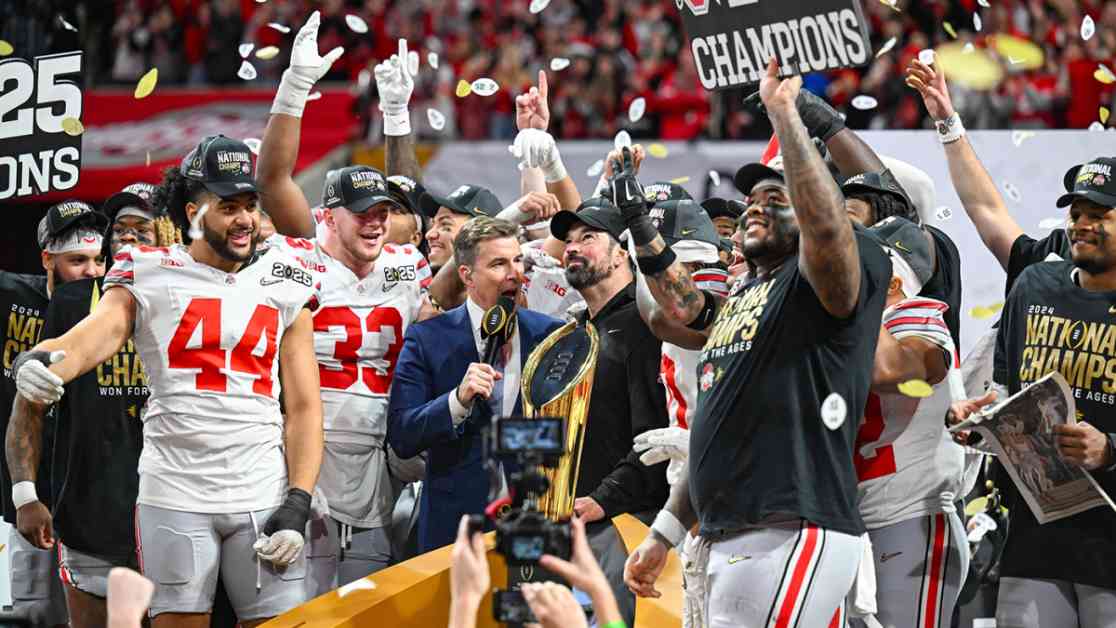In the wake of Ohio State and Notre Dame’s victories in the College Football Playoff semifinals, the focus shifted to the significance of traditional roster construction in the modern era of college football. While the chatter centered around conference strength and representation, there was a unique connection between Ohio State and Notre Dame that set them apart from other powerhouse programs in the sport.
In an age where transfer rules and Name, Image, and Likeness (NIL) opportunities have fostered roster fluidity, Ohio State and Notre Dame emerged as anomalies by not heavily relying on the transfer portal for roster building. Despite notable transfers like Will Howard, Quinshon Judkins, and Caleb Downs for the Buckeyes, and Riley Leonard for the Fighting Irish, both teams maintained lower transfer volumes compared to their power-conference rivals.
Ohio State and Notre Dame each acquired a modest number of transfers over the past three offseasons, totaling 20 combined, while other programs added at least 20 transfers in a single offseason. Teams like Ole Miss and Louisville consistently bolstered their rosters with transfer additions, showcasing a stark contrast to the transfer strategies adopted by the national championship contenders.
Does the Transfer Portal Hold the Key to Success?
Analyzing data from the past three years of transfer portal activity at the power conference level unveils a correlation between the number of transfers and on-field success. Programs that heavily relied on the transfer portal, labeled as “portal teams,” often witnessed rapid roster turnover and immediate performance upgrades.
Notably, new head coaches capitalized on the portal as a tool for talent infusion, with over half of the 20-plus transfer classes initiated by coaches in their initial seasons. Coaches like Deion Sanders, Curt Cignetti, Jeff Brohm, Kenny Dillingham, and Rhett Lashlee leveraged the portal to revamp their rosters and achieve substantial success early in their tenures.
As demonstrated by the rise of Indiana, Arizona State, and SMU in the College Football Playoff, aggressive portal activity can expedite a program’s path to conference titles and national prominence. The success stories of these portal-reliant teams underscore the transformative potential of strategic transfer acquisitions in reshaping a program’s trajectory.
The Portal’s Role in National Championship Aspirations
While portal-heavy teams like Indiana and SMU secured playoff berths, the majority of the 2024-25 College Football Playoff contenders had limited transfer acquisitions. Georgia, Ohio State, and Texas epitomized a balanced approach, combining elite high school recruiting with targeted portal additions to establish championship-caliber rosters.
The essence of a true national championship contender lies in recruiting blue-chip prospects and fostering long-term roster depth through consistent high school recruiting success. Despite the allure of the transfer portal for quick fixes, sustaining success in the grueling college football landscape demands a foundation built on recruiting prowess and player development.
The enduring relevance of Bud Elliott’s Blue Chip Ratio in predicting national champions underscores the enduring value of high school recruiting in shaping elite programs. While portal teams can make playoff appearances, the absence of home-grown talent poses a significant obstacle to winning the ultimate prize in college football.
In Conclusion, the Transfer Portal: A Catalyst for Change
As college football navigates the evolving landscape of the transfer portal, programs like Oregon offer a blueprint for a hybrid model that balances high school recruiting with strategic portal acquisitions. Oregon’s success under Dan Lanning exemplifies the synergy between building a strong in-house foundation and supplementing the roster with transfer talent.
Amidst uncertainties surrounding the future of the transfer portal, a shift towards roster retention and increased emphasis on talent development emerges as a counterpoint to the portal frenzy. The recalibration of priorities towards roster continuity signifies a potential ceiling for portal-driven teams, as traditional powerhouses continue to dominate the championship conversation with a blend of recruiting acumen and strategic portal utilization.
As the college football landscape continues to evolve, the transfer portal remains a potent force for change, challenging programs to adapt and innovate in pursuit of sustained success on the national stage. While the allure of instant upgrades through transfers persists, the enduring value of recruiting excellence and player development underscores the timeless principles that underpin championship-caliber programs in the ever-evolving realm of college football.












